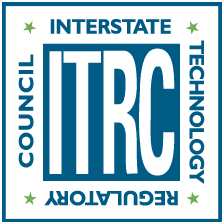Appendix E: Acronyms
2,4-DNT 2,4-dinitrotoluene
ADEC Alaska Department of Conservation
AL action level
AQC analytical quality control
ASTM ASTM International, formerly American Society for Testing and Materials
ATON aid to navigation
BaP benzo(a)pyrene
BTEX benzene, toluene, ethylbenzene, and xylenes
BCa bias-corrected accelerated bootstrap method
CAG community advisory group
CCA chromium, copper, and arsenic
CE2 long-range heterogeneity fluctuation error
CE3 periodic heterogeneity fluctuation error
CEC cation exchange capacity
CFR Code of Federal Regulations
CH compositional heterogeneity
CI confidence interval
CLT central limit theorem
cm centimeter
cm2 centimeters squared
cm3 centimeters cubed
CMIST U.S. Army Corps of Engineers multi-increment sampling tool
COC chemical of concern (or contaminants of concern)
COI chemical of interest
COPC chemical of potential concern
CRA contingency reserve area
CRREL U.S. Army Cold Regions Research and Engineering Laboratory
CSM conceptual site model
CV coefficient of variation
d diameter
df degrees of freedom
DGR Dangerous Goods Regulations
DH distributional heterogeneity
DHHL Department of Hawaiian Home Lands
DHS U.S. Department of Homeland Security
DLNR State of Hawaii Department of Land and Natural Resources
DNT dinitrotoluene
DOD U.S. Department of Defense
DOE U.S. Department of Energy
DQO data quality objective
DTSC California Department of Toxic Substances
DU decision unit
DUA data usability assessment
EE extraction error
ECOS Environmental Council of the States
EDQW Environmental Data Quality Working Group
ELAP Environmental Laboratory Accreditation Program
EPC exposure point concentration
ERIS Environmental Research Institute of the States
ESTCP Environmental Security Technology Certification Program
EU exposure unit
EUa exposure unit for adults
EUc exposure unit for children
FDA U.S. Food and Drug Administration
FDEP Florida Department of Environmental Protection
FE fundamental error
FOT fields of testing
ft2 square feet
g gram
GIS geographic information system
GM geometric mean
GNSS global navigation satellite system
GPS Global Positioning System
GSD geometric standard deviation
GSE grouping and segregation error
H0 null or baseline hypothesis
H1 alternate hypothesis
HDOH Hawaii Department of Health
HMX octahydro-1,3,5,7-tetranitro-1,3,5,7-tetrazocine
IA investigation area
IATA International Air Transport Association
IBT internet-based training
IDQTF Intergovernmental Data Quality Task Force
IS incremental sample (or incremental sampling)
ISM Incremental Sampling Methodology
ISO International Organization for Standardization
ITRC Interstate Technology & Regulatory Council
KM Kaplan-Meier
LCL lower confidence limit
LCS laboratory control sample (or laboratory control spike)
LDR Land Disposal Restrictions
LORAN Long Range Navigation
LUST leaking underground storage tank
M maps
MARLAP Multi-Agency Radiological Laboratory Analytical Protocols Manual
MDL method detection limit
MEDEP Maine Department of Environmental Protection
mg/kg milligram per kilogram
MI multiple increment
mm millimeter
mm Hg millimeter mercury vapor pressure
MMRP Military Munitions Response Program
MPC measurement performance criteria
MQO measurement quality objective
Ms mass of the collected sample
MS matrix spike
MSD matrix spike duplicate
n number of increments or sample size
NAEG Nevada Applied Ecology Group
nCi nanocurie
ND non-detect
NELAP National Environmental Laboratory Accreditation Program
N&E DU nature and extent decision unit
NIST U.S. National Institute of Standards and Technology
NRC Nuclear Regulatory Commission
OCP organochlorine pesticides
OLEM Office of Local Environmental Management
ORD USEPA Office of Research and Development
OSWER Office of Solid Waste and Emergency Response
oz ounce
PAH polyaromatic hydrocarbon
PAL project action level
Pb lead
PCB polychlorinated biphenyl
PCP pentachlorophenol
PD probability distribution
PETN pentaerythritol tetranitrate
PFAS per- and polyfluoroalkyl substances
PHC petroleum hydrocarbons
PID photo-ionization detector
ppm parts per million
PNNL Pacific Northwest National Laboratory
ProUCL USEPA statistical software package for analysis of environmental datasets
QA quality assurance
QAPP quality assurance project plan
QC quality control
QSM Quality Systems Manual
r replicates
RAG Remedial Action Guideline or Risk Assessment Guidance
RCRA Resource Conservation and Recovery Act
RDX 1,3,5-trinitroperhydro-1,3,5-triazine
RL reporting limit
RPD relative percent difference
RSD relative standard deviation
Sb antimony
SD standard deviation
SE sampling error (or standard error)
SIM selective ion monitoring
SMD scrap metal dump
SOP standard operating procedure
SPP systematic planning process
sqrt square root
SRM standard reference manual
SU sampling unit
SVOC semi-volatile organic compound
TAG technical assistance grantee
TCEQ Texas Commission on Environmental Quality
TCLP Toxicity Characteristic Leaching Procedure
TGM Technical Guidance Manual
TOS theory of sampling
TPP technical project planning
t-UCL Student’s-t
µ population mean
UCL upper confidence limit
UFP-QAPP uniform federal policy for quality assurance project plans
UPL upper prediction limits
USACE U.S. Army Corps of Engineers
USDA U.S. Department of Agriculture
USEPA U.S. Environmental Protection Agency
UTL upper tolerance limit
UV ultraviolet
VOC volatile organic compound
VSP Visual Sample Plan
WP work plan XRF X-ray fluorescence
Click Here to download the entire document.


